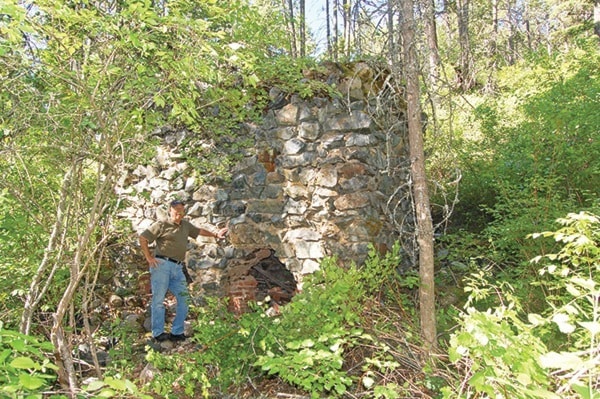Editor’s Note:
R.M. Simbrec was a featured columnist to the Gazette in the 1990s. The column was titled “Kettle River Journal: Memories form the Boundary Country’s Pioneers.”
When Sarto Cyr recently re-discovered the rock structure, interest sparked anew.
That it was a bake oven was the best guess until Simbrec reminded us of a Journal column entitled “The Hidden Smelter.” Here is the column reprinted with permission from the author.
THE HIDDEN SMELTER
Standing at the base of a rock bluff is an unusual site, a home-built smelter. It is within sight of the Old North Fork Road, across the valley from Gasston's, above the old Rella farm. If you're looking on a mining district map, it is the Coin Mineral Grant.
If you're energetic and wish to hike in to see it, take the old road that starts at the gravel pit across from Beliveau's. Take time to admire the cement work away up above on the rail grade.
After panting and puffing up two steep hills, the road levels and forks. Take the right fork and walk until you come to a new wire fence. At this point you've gone past the smelter, so turn back and look up the mountain on your right. There, 200 feet from the fence, on the side in the brush, is an amazing structure. Built of rock, it is 10 feet high, 16 feet in length, and 10 feet in width. Roughly rectangular on the outside, the centre is oval. Two brick arches, each four feet wide by three feet high, are lined with brick. The brick appears to have been homemade; seven rows line the 34-inch depth of the main structure.
It is a monument to one man's stubbornness and tenacity, for the man who built his own smelter didn't trust the smelter at Grand Forks. Time has blurred the details, but when Ted Wassholm was timber cruising in 1940 and came across the structure, he took Dan Turcotte and the late Randy Sandner to see it At that time there was a ramp built to the top of the structure and a wooden wheeled wheelbarrow nearby. These have long since disappeared.
It would appear that a stubborn old prospector discovered what he thought was high-grade ore on the ridge nearby. He was so certain that in 1888 the Gold Coin Mining Co. Ltd. issued stock certificates in the mine. The assay came back: zinc with trace amounts of gold and silver. Old Fred, the prospector, didn't believe the assayer. He just kept right on digging
his holes. By 1899 he had a tunnel in 100 feet and thought he was ready to ship to the new
smelter at Grand Forks.
Down he went with a pack train of ore. The smelter ran an assay and refused to take the ore. It was zinc, which had no value in those days.
Fred, known to be stubborn, didn't trust anybody by this time, so decided to build his own smelter. He had built a log cabin a short distance away (remnants still visible), decided
he would show all those city slickers at the Granby Co.
Working alone, using local stone and powdering nearby, limestone for mortar, he built his smelter, day by day, layer by layer. The structure has a slight list, but time may have
caused it to shift.
To make his own coke for fuel he cut down jackpine trees. Then he started his smelting process: a layer of coke on the bottom of the smelter, a layer of ore, a layer of coke and a
raging hot fire. When he finished he took the matte in to town for assaying. Once again,
despite all his work, he still had zinc. How many times he tried again is unknown.
Today, if you crawl carefully in through the archway and look at the stone walls, one can see where there has been fire so hot the rock and mortar have fused.
Randy Sandner, who knew the story, took a sample and had it assayed. It again showed
zinc with trace amounts of gold and silver.
B.C. Mining Report shows a Fred Wollaston (?) staked the Gold Coin (later just the
Coin) and that he shipped a total of 20 tons in 1899 and six tons in 1900.
It is an interesting area, for if you climb the ridge back and look down below the knarled
old pine tree above and back of the smelter, there are five main diggings and numerous small
holes. The tunnel appears to have been blasted in, perhaps at a later date.
It leaves so many questions unanswered as you look around. How long did it take to build the smelter? How did he get the ore to it? Did he use the wooden barrow or pack it in buckets or sacks?
How much ore did he burn in the smelter, how many times of back-breaking labour before he gave up his dream? Did he go on to strike it rich at another glory hole?
My thanks to all those helping to piece together the story of the Forgotten Smelter: Ray
Johnson, Jim Glanville, Gigi Rossi, Jack Carson and Dan Turcotte. Also to staff at the
Government Agent's Office. It is a fascinating story, just one of the many told in the
Boundary.
